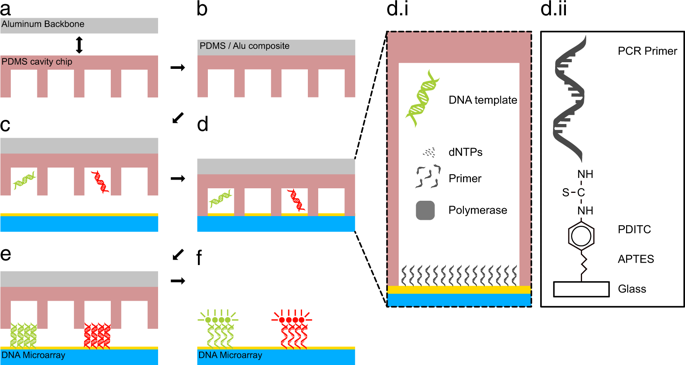Scientific Reports ( IF 3.8 ) Pub Date : 2020-04-01 , DOI: 10.1038/s41598-020-62404-1 Johannes Wöhrle 1, 2, 3 , Stefan D Krämer 1, 3, 4 , Philipp A Meyer 1, 2, 3 , Christin Rath 1, 3, 4 , Matthias Hügle 2, 5 , Gerald A Urban 2, 6 , Günter Roth 1, 3, 4, 6, 7

|
In this work we show how DNA microarrays can be produced batch wise on standard microscope slides in a fast, easy, reliable and cost-efficient way. Contrary to classical microarray generation, the microarrays are generated via digital solid phase PCR. We have developed a cavity-chip system made of a PDMS/aluminum composite which allows such a solid phase PCR in a scalable and easy to handle manner. For the proof of concept, a DNA pool composed of two different DNA species was used to show that digital PCR is possible in our chips. In addition, we demonstrate that DNA microarray generation can be realized with different laboratory equipment (slide cycler, manually in water baths and with an automated cartridge system). We generated multiple microarrays and analyzed over 13,000 different monoclonal DNA spots to show that there is no significant difference between the used equipment. To show the scalability of our system we also varied the size and number of the cavities located in the array region up to more than 30,000 cavities with a volume of less than 60 pL per cavity. With this method, we present a revolutionary tool for novel DNA microarrays. Together with new established label-free measurement systems, our technology has the potential to give DNA microarray applications a new boost.
中文翻译:

在玻璃基板上生成数字DNA微阵列。
在这项工作中,我们展示了如何以快速,简便,可靠和经济高效的方式在标准显微镜载玻片上分批生产DNA微阵列。与经典微阵列产生相反,微阵列通过数字固相PCR产生。我们已经开发了一种由PDMS /铝复合材料制成的空腔芯片系统,该系统允许以可扩展且易于操作的方式进行此类固相PCR。为了证明这一点,使用了由两种不同的DNA组成的DNA池来证明在我们的芯片中可以进行数字PCR。此外,我们证明了可以使用不同的实验室设备(载玻片循环仪,在水浴中手动操作和使用自动盒系统)来实现DNA微阵列的产生。我们生成了多个微阵列并分析了13个以上 000个不同的单克隆DNA斑点表明所用设备之间没有显着差异。为了显示我们系统的可扩展性,我们还改变了位于阵列区域中的腔的大小和数量,最多改变了30,000个腔,每个腔的容积小于60 pL。通过这种方法,我们为新型DNA微阵列提供了一种革命性的工具。与新建立的无标签测量系统一起,我们的技术有可能为DNA微阵列应用带来新的推动力。











































 京公网安备 11010802027423号
京公网安备 11010802027423号